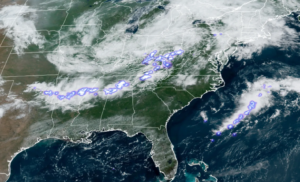The dramatic weather system sweeping the East Coast is one of this year’s most destructive. Severe thunderstorms began developing Monday in a line stretching from the Gulf Coast midway across the East Coast to New England.

In their wake, at least two people have lost their lives, power outages have left more than 1.1 million homes and businesses powerless, and damages are still being assessed as storm waters recede.
The stormy weather comes as no surprise, following a summer of abnormally high temperatures and corresponding weather events, which have battered the East Coast from the Mid-Atlantic states to Pennsylvania and New York.
Real-time descriptions of the violent conditions given by meteorologist Chris Strong painted a precarious picture of the extreme weather that affected nine states. “This does look to be one of the most impactful severe weather events across the Mid-Atlantic that we have had in some time,” he warned.
You can see some of the damage caused by these storms in Tennesee below.
The damage from severe storms this afternoon is widespread and extensive. Crews began working immediately to assess damage and make repairs, and approximately 40,000 customers are without power. Due to the severe and widespread nature of the damage, we expect restoration efforts… pic.twitter.com/dDdZyVnGmD
— Knoxville Utilities Board (@KnoxKUB) August 7, 2023
Over 8,000 flights have since been delayed and 2,600 canceled, while travel along many roads has been deemed hazardous. Over 80 million people across the Eastern Time Zone were declared at risk for dangerous wind speed, flash flooding, and tornadoes.
The death toll was limited to two after prompt and tireless work by law enforcement, first responders, and utility crews. A 15-year-old boy in South Carolina fell victim to a collapsing tree, while a 28-year-old Alabama man was struck by lightning.
Businesses have been ravaged, with winds of up to 140mph tearing roofs from Buffalo, New York buildings. Storms have been so destructive that over 30 utility poles were knocked down in Westminster, Maryland, causing live wires to rain down on thirty vehicles.
Most significantly, roads have been submerged in cities such as Morgantown and Parkersburg, West Virginia. The National Weather Service has even issued tornado warnings in multiple states, including Tennessee and New York.
It is timely, then, that FEMA Administrator Deanne Criswell has reminded Americans of the importance of readiness and self-reliance in dealing with natural disasters. The agency is, in fact, nearly out of funds for 2020 disaster relief, having spent more than $1 billion.
The unusually high temperatures of the Atlantic Ocean are also driving hurricane estimates up as the peak of the hurricane season approaches. This, coupled with the relentless weather systems, which appear to be increasing in intensity and longevity, has created a situation of high alert for the US population.

People are rightfully starting to worry about the unpredictable bombardment of severe weather and the potential ramifications for their homes and businesses. It is arguably the government’s responsibility to ensure the preparedness and safety of neighboring populations to ensure each other’s well-being.
Though the storm has passed, the full scope of damage remains to be seen. Let us all hope for a swift recovery and more effective preventative measures against the effects of extreme weather.


